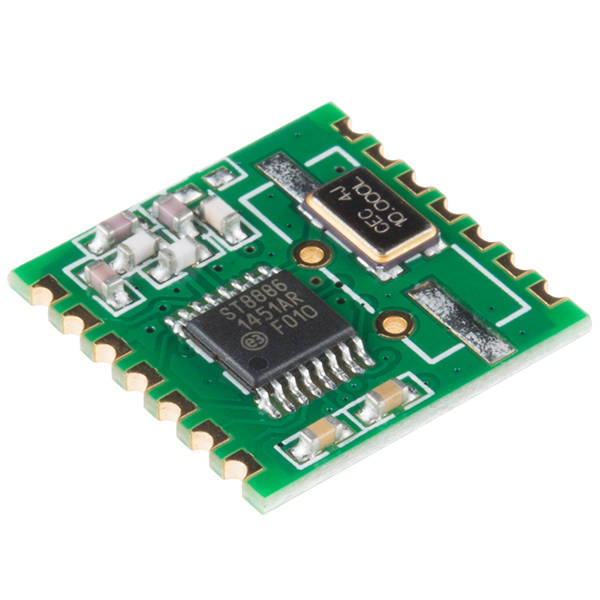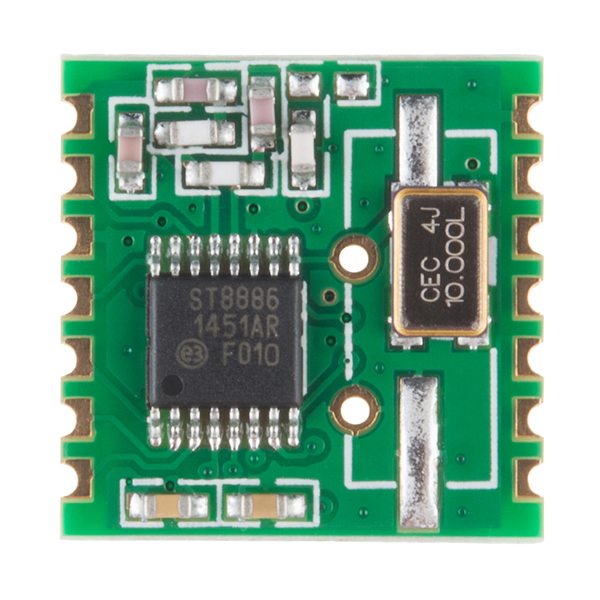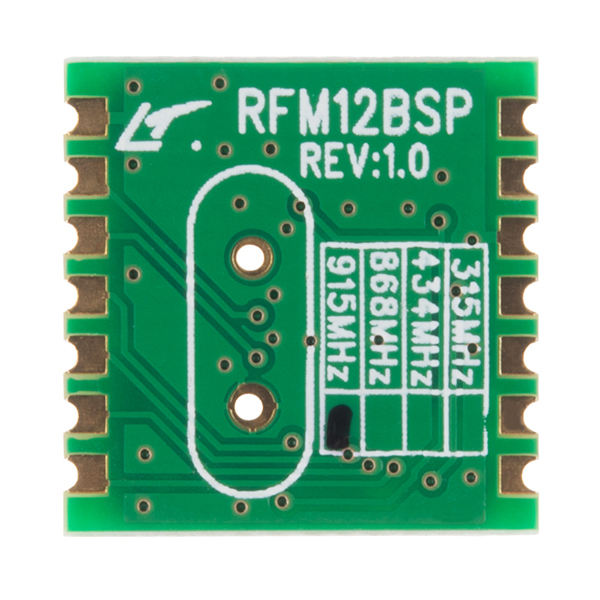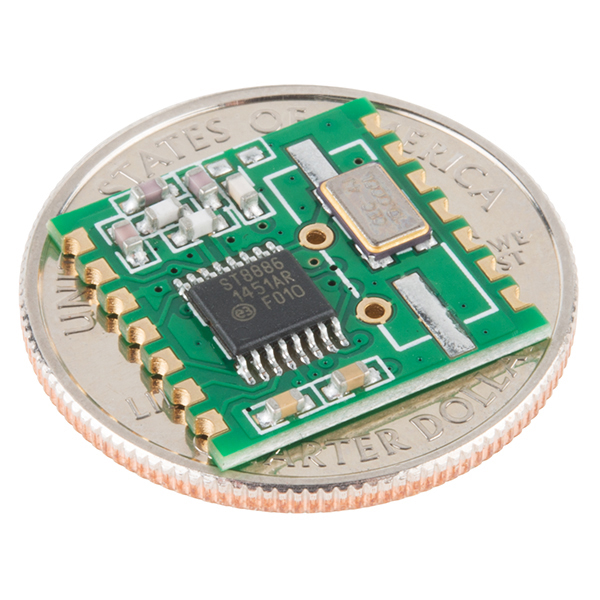RFM12B-S2 Wireless Transceiver - 915MHz
The RFM12B is a great inexpensive option for wireless communication; it's an ISM band FSK transceiver module implemented with a unique PLL. These modules operate in the 915MHZ band and fully comply with FCC and ETSI regulations.
This module has a wide voltage supply range of 2.2-3.8VDC. An SPI interface is used to send data and configure the RFM12 module. The configuration commands, described in the RF12 IC Datasheet linked below, can be used to set the data rate, frequency band, wake-up timer, transfer data, receive data from the 16-bit FIFO, and much more.
The module comes in a 14-pin SMD package, with pins spaced by 2mm. Check below for a breakout board.
- Low-cost, high-performance
- SPI compatible interface
- High data rate (up to 115.2 kbps in digital mode)
- Wakeup timer
- 2.2V-3.8V power supply
- Analog and digital RSSI outputs
- Differential antenna input
- Automatic antenna tuning
- 16-bit RX data FIFO
- PLL and zero IF technology
- Fast PLL lock time
- High resolution PLL with 2.5KHz step
- Programmable TX frequency deviation (from 15 to 240 kHz)
- Programmable receiver bandwidth (from 67 to 400 kHz)
- Analog and digital signal strength indicator
- Internal data filtering and clock recovery
- Clock and reset signal output for external MCU use
- 10MHz crystal for PLL timing
- 15.9 x 16.1 mm (0.626 x 0.634 in)
RFM12B-S2 Wireless Transceiver - 915MHz Product Help and Resources
Core Skill: Soldering
This skill defines how difficult the soldering is on a particular product. It might be a couple simple solder joints, or require special reflow tools.
Skill Level: Competent - You will encounter surface mount components and basic SMD soldering techniques are required.
See all skill levels
Core Skill: Programming
If a board needs code or communicates somehow, you're going to need to know how to program or interface with it. The programming skill is all about communication and code.
Skill Level: Competent - The toolchain for programming is a bit more complex and will examples may not be explicitly provided for you. You will be required to have a fundamental knowledge of programming and be required to provide your own code. You may need to modify existing libraries or code to work with your specific hardware. Sensor and hardware interfaces will be SPI or I2C.
See all skill levels
Core Skill: Electrical Prototyping
If it requires power, you need to know how much, what all the pins do, and how to hook it up. You may need to reference datasheets, schematics, and know the ins and outs of electronics.
Skill Level: Competent - You will be required to reference a datasheet or schematic to know how to use a component. Your knowledge of a datasheet will only require basic features like power requirements, pinouts, or communications type. Also, you may need a power supply that?s greater than 12V or more than 1A worth of current.
See all skill levels
Comments
Looking for answers to technical questions?
We welcome your comments and suggestions below. However, if you are looking for solutions to technical questions please see our Technical Assistance page.
Customer Reviews
4 out of 5
Based on 2 ratings:
1 of 1 found this helpful:
Does not have .1" pin spacing
And that make's it really hard to prototype. I soldered really thin wires to male dip headers so that I could wire it up. SInce that took a few hours I have yet to power it up.
Works great!
You can buy them for $3.50 direct from the manufacturer...if you don't mind waiting for the shipping from China. Great product though and I have used both the 915mhz and 433mhz.





If anyone is interested, I posted this on the 433MHz RFM12B product page too, I got some breakout boards for these modules (the 433MHz ones in my case) from here:
RFM12B Breakout Board solder yourself: http://modtronicsaustralia.com/shop/rfm12b-breakout-board-bare-pcb-rf-wireless-module/
RFM12B Breakout Board with soldered module: http://modtronicsaustralia.com/shop/rfm12b-breakout-board-wireless-module/
If anyone is interested turnkey solution of 433MHz, pls check this link; http://www.appconwireless.com/PRODUCTS/showproduct.php?lang=en&id=7
Any chance of having the 868MHz version here in the future?
Could a pair of these be used to make a remote connection for an I2C interface? I want to link a temperature sensor with an I2C interface to an Arduino.
Been there, done that with an 8051 system, the catch isnt frequency, its loss of shape of the digital pulses. They have to be received reasonably clean and square.
Should work if the i2C data rate is "slow" See:
i2c-bus.org/speed/
The above site states three data rates, the slowest is 100 Kb. That is less than the 115.2 Kb rate claimed in the ad.
For a temp sensor, theres no need for a high speed bus, the sensor itself can probably only respond on the order of 1/10 th second.
if youre unsure of the data rate, look at the clock speed.
Use an oscilloscope to verify received pulses, there's only so much rounding of the pulses that can be tolerated and still have valid zeros and ones to a data system.
Long range low power TRX modules are available now. http://www.hoperf.com/rf/lora/778.htm
If this transceiver was on the same frequency range (915Mhz), could it communicate with the RFM22B with little or no differencre from communicating with it's "own kind" - or vise versa?
I am wondering because I have some sensors in a sensor network that could use the shorter range rfm12b, but others that need the longer range rfm22b (Which is twice as expensive and something that I would like to avoid using on all the boards if possible)
If anyone can help / point me in the right direction, Thanks
What type/length of antenna is anyone using (that seems to work?)
what is the line of sight range on these modules?, also, how well do they work indoors?
Could this module be used for transmitting an encoded bitstream to say, a speaker? The bitstream bitrate would be around 128kbps. The speaker would have a receiver, a bitstream decoder, and an amp. I'm thinking DIY wireless surround speakers. The wireless speakers could number to up to 4. Would that mean that I need to get four different frequency wireless modules for the speakers and 4 more for the transmitter?
These are great wireless modules. For an alternate Arduino library and development platform, see the JeeLabs website. My ColorNode board can also be used as a simple breakout board for this module and is based off of the JeeNode. The design is shared on OSHPark.